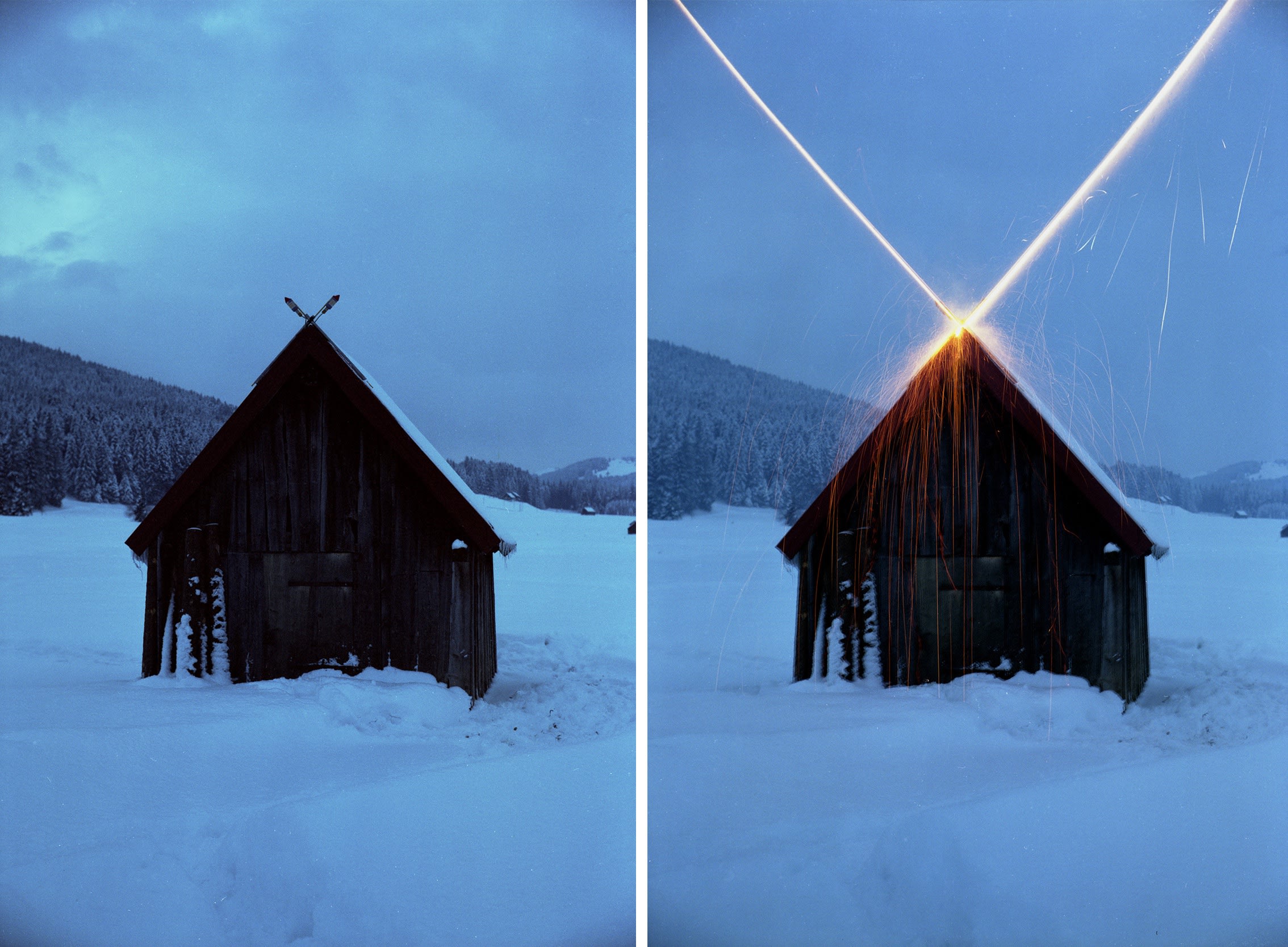John Massey: Red White & Blue
Opening: Thursday, February 1, 6 - 9pm
Exhibition: 1 February - 16 March, 2024
"[The Engraver's] characters are invariably white, the majority are men and all are cast in narratives that cumulatively present ideals of order, authority and certainty. Massey retains these typologies, but in a form that is sullied and ridiculed."
CRG presents the first exhibition of hybrid paintings from John Massey's recent, pivotal series, Red White & Blue at 190 St Helens Avenue in Toronto.
The germination of Red White & Blue followed Trump's election in 2016. The world had changed. In an antique store Massey found a collection of volumes presenting compendia of steel-cut etchings made in the middle of the 19th century. Payne's Universum and Galleries of Munich, edited by Charles Edwards between 1845 and 1847, comprise, in Edward's words, "a collection of engravings of views in all countries, portraits of great men, and specimens of works of art, of all ages and of every character." It became to clear to Massey that the images in these leather-bound books were an attempt to create a generalized idea of how art was portrayed at the time: bucolic country scenes, portraits, the painter's studio and the like.
Sensing the parallels between Payne's stereotypical world and that of a Trumpian America, Massey began digitizing and manipulating select images from the collection. Beginning only with the engravings themselves, but then through the subsequent addition of the odd contemporary object (cinematic faces, "open" sign flags, modern weapons etc.), pictures of a distorted reality began to appear. Painting deep hues of red and blue onto select portions of each image abstracted the found narratives, transforming them into contemporary imperial vignettes. The results suggest a social disassociation, arising from the distorted representations that reflect the overarching values of a post-truth world.
"John Massey's projects are frequently linked to the camera, and to photo-conceptualism. Even if, in recent years, he has consummately embraced the possibilities of digital manipulation, the resulting images have been in their final form photomechanically produced and are thereby reproducible as editions. While this latest project, titled RED WHITE & BLUE continues to construct works digitally, the final stage of the process involves the manual application of paint to sections of the surface, which in turn dominate the image and hit the eye with astonishing force. This use of paint ostensibly represents a jump in Massey's practice, in that it both transforms the image into a photo-digital and painted amalgam and also produces a unique image that cannot be reproduced. Coupled with this jump is the direct manipulation of pre-existing artworks, albeit 19th century editioned engravings that are themselves stylized interpretations of paintings in European museum collections. Previous projects have exploited canonical works from art's history to Massey's own ends, but never before has he so emphatically sequestered and radically deformed an existing image. However, neither in citing art history, nor in producing unique painted images is Massey marshalling any claim to authenticity. Rather, RED WHITE & BLUE, which most obviously references the US flag, alludes to the impossibility of authenticity at a moment when "truth, and the possibility of critical observation, is under attack."* This is the cornerstone of the project and it represents a far more profound shift in his practice than simply a change in subject matter, material or medium.
With RED WHITE & BLUE Massey disavows his enquiry into how the self is actualized, to the point of questioning that enquiry's continuing validity in this moment of political upheaval, where the relationship between representation and truth has become acutely unhinged. Instead he reflects on the ensuing crisis for liberal democracy and the consequent dismantling of the principles and constitutional checks and balances that underpin its institutions. The starting points for the project are steel engravings by A.H. Payne published in a series of books in the mid 19th century, when liberal democracies were on the rise across Europe and the Americas and the impacts of the Industrial Revolution were being fully felt; impacts that included the major expansion of the middle class, the target market for Payne's books. Massey came across the books shortly after the 2016 US election, a watershed moment -and a demoralizing one for Massey -that epitomized and ramped up an inherent cynicism underpinning a global political turn. Using the engravings as source material Massey saw an opportunity to respond to a cultural psyche the election ushered in by addressing both the historical rise of liberal values in the West and, importantly, their current insidious erosion."
Excerpts from an essay by Gregory Burke.
About John Massey: Since 1979, Canadian artist John Massey has exhibited nationally and internationally. He has worked variously in installation, video, photography and sculpture. Over the years he has developed a visual language that embodies conceptual content, questioning both personal and public paradigms. Selected exhibitions include "La Biennale de Montréal," Musée d'Art Contemporain de Montréal, Montréal, 2014; "Looking Out and Looking In: A Selection Of Contemporary Photography," Albright-Knox Art Gallery, Buffalo, 2013; "Envisioning Buildings: Reflecting Architecture in Contemporary Art Photography," MAK Exhibition Hall, Vienna, 2012; "Marburg! The Early Bird!" Marburger Kunstverein, Marburg, 2010; "Cinema Paradiso," Australian Centre for Contemporary Art, Melbourne, 2007; "Beyond Cinema: The Art of Projection," Hamburger Bahnhof, Berlin, 2006; "John Massey: The House That Jack Built," Canadian Museum of Contemporary Photography, Ottawa, 2004; "Adorno," Franfurter Kunstverein, Frankfurt, 2003; and "Passages de l'image," Centre Georges Pompidou, Paris, 1990.
Massey's work is housed in institutional collections including those of the National Gallery of Canada, Ottawa; the Art Gallery of Ontario, Toronto; the Albright-Knox Art Gallery, Buffalo; the Musée d'Art Contemporain de Montréal, Montréal; the Stedelijk Museum, Amsterdam; and the Ydessa Hendeles Art Foundation, Toronto, as well as numerous private and corporate collections.
* The artist would like to thank artist Amanda Boulos for her vital contribution to this project.


